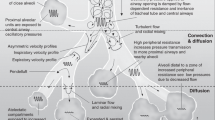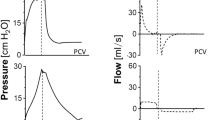Abstract
Objective:
To examine the role of frequency in high-frequency ventilation (HFV) on carbon-dioxide (CO2) elimination and lung injury, independent of its effect on tidal volume.
Study Design:
An anatomically representative lung model was attached to a mechanical ventilator capable of providing HFV with a constant volume. CO2 was infused directly into the lung, and a commercially available end-tidal CO2 detector was used to determine CO2 elimination. CO2 elimination and amplitude of pressure transmissions were evaluated using frequencies ranging from 5 to 15 Hz. The pressure–volume index (PVI) was described as the product of the volume and pressures delivered to the lung, a surrogate for lung injury.
Result:
The use of increasing frequencies directly correlated with improved CO2 clearance when keeping the tidal volume fixed, expressed as percent CO2 remaining in the lung at 25 s (66.5 (±1.1)%, 50.5 (±0.1)% and 37.8 (±0.3)% at 5, 10 and 15 Hz, respectively, P<0.05). With a fixed tidal volume, there was a decrease in pressure amplitudes transmitted to the lung with a decline in the PVI (53.9 (±2.7) mmHg ml−1, 41.1 (±0.9) mmHg ml−1 and 23.4 (±3.6) mmHg ml−1, at 5, 10 and 15 Hz, respectively, P<0.05).
Conclusion:
Frequency has a direct relationship with CO2 elimination when tidal volume is fixed. Using low delivered tidal volumes and high frequencies may allow for improved ventilation efficacy, while minimizing lung injury.
This is a preview of subscription content, access via your institution
Access options
Subscribe to this journal
Receive 12 print issues and online access
$259.00 per year
only $21.58 per issue
Buy this article
- Purchase on Springer Link
- Instant access to full article PDF
Prices may be subject to local taxes which are calculated during checkout




Similar content being viewed by others
References
Ventre KM, Arnold JH . High frequency oscillatory ventilation in acute respiratory failure. Paediatr Respir Rev 2004; 5: 323–332.
Moriette G, Brunhes A, Jarreau PH . High-frequency oscillatory ventilation in the management of respiratory distress syndrome. Biol Neonate 2000; 77: 14–16.
Pillow JJ . High frequency oscillatory ventilation: Mechanisms of gas exchange and lung mechanics. Crit Care Med 2005; 33: S135–S141.
McCulloch PR, Forkert PG, Froese AB . Lung volume maintenance prevents lung injury during high frequency oscillatory ventilation in surfactant-deficient rabbits. Am Rev Respir Dis 1988; 137: 1185–1192.
Yoder BA, Siler-Khodr T, Winter VT, Coalson JJ . High-frequency oscillatory ventilation: effects on lung function, mechanics, and airway cytokines in the immature baboon model for neonatal chronic lung disease. Am J Respir Crit Care Med 2000; 162: 1867–1876.
Cools F, Askie LM, Offringa M, Asselin JM, Calvert SA, Courtney SE et al. Elective high-frequency oscillatory versus conventional ventilation in preterm infants: a systematic review and meta-analysis of individual patients’ data. Lancet 2010; 375: 2082–2091.
Courtney SE, Durand DJ, Asselin JM, Hudak ML, Aschner JL, Shoemaker CT et al. High-frequency oscillatory ventilation versus conventional mechanical ventilation for very-low-birth-weight infants. N Eng J Med 2002; 347: 643–652.
Johnson AH, Peacock JL, Greenough A, Marlow N, Limb ES, Marston L et al. High-frequency oscillatory ventilation for the prevention of chronic lung disease of prematurity. N Eng J Med 2002; 347: 633–642.
Froese AB, Bryan AC . High frequency ventilation. Am Rev Respir Dis 1987; 135: 1363–1374.
Weinmann GG, Mitzner W, Permutt S . Physiological dead space during high-frequency ventilation in dogs. J Appl Physiol Respir Environ Exerc Physiol 1984; 57: 881–887.
Boynton BR, Hammond MD, Fredberg JJ, Buckley BG, Villanueva D, Frantz ID 3rd . Gas exchange in healthy rabbits during high-frequency oscillatory ventilation. J Appl Physiol 1989; 66: 1343–1351.
High Frequency Oscillatory Ventilation (HFOV) in Newborn Services Clinical Guideline http://www.adhb.govt.nz/newborn/guidelines/respiratory/hfov/hfov.htm. Accessed 19 January 2014.
Hatcher D, Watanabe H, Ashbury T, Vincent S, Fisher J, Froese A . Mechanical performance of clinically available, neonatal, high-frequency, oscillatory-type ventilators. Crit Care Med 1998; 26: 1081–1088.
Ghazanshahi SD, Khoo MCK . Optimal application of high-frequency ventilation in infants: A theoretical study. IEEE Trans Biomed Eng 1993; 40: 788–796.
Venegas J, Fredberg JF . Understanding the pressure cost of ventilation: why does high-frequency ventilation work?. Crit Care Med 1994; 22: S49–S57.
Rieke H, Hook C, Meyer M . Pulmonary gas exchange during high-frequency ventilation in dogs. Respir Physiol 1983; 54: 1–17.
Watson JW, Jackson AC, Gillespie JR . CO2 elimination and airway opening pressure during high frequency oscillation in dogs. Respir Physiol 1984; 58: 235–244.
Chan A, Jayasuriya K, Berry L, Roth-Kleiner M, Post M, Belik J . Volutrauma activates the clotting cascade in the newborn but not adult rat. Am J Physiol Lung Cell Mol Physiol 2006; 290: L754–L760.
Copland IB, Martinez F, Kavanagh BP, Engelberts D, McKerlie C, Belik J et al. High tidal volume ventilation causes different inflammatory responses in newborn versus adult lung. Am J Respir Crit Care Med 2004; 169: 739–748.
Copland IB, Kavanagh BP, Engelberts D, McKerlie C, Belik J, Post M . Early changes in lung gene expression due to high tidal volume. Am J Respir Crit Care Med 2003; 168: 1051–1059.
Zimová-Herknerová M, Plavka R . Expired tidal volumes measured by hot-wire anemometer during high-frequency oscillation in preterm infants. Pediatr Pulmonol 2006; 41: 428–433.
Dimitriou G, Greenough A, Kavvadia V, Laubscher B, Milner AD . Volume delivery during high frequency oscillation. Arch Dis Child Fetal Neonatal Ed 1998; 78: F148–F150.
Acknowledgements
This study received no specific funding.
Author information
Authors and Affiliations
Corresponding author
Ethics declarations
Competing interests
MSL declares having received advisory board consulting fees from Drager. The remaining authors declare no conflict of interest.
Additional information
Supplementary Information accompanies the paper on the Journal of Perinatology website
Supplementary information
Rights and permissions
About this article
Cite this article
Mukerji, A., Belik, J. & Sanchez-Luna, M. Bringing back the old: time to reevaluate the high-frequency ventilation strategy. J Perinatol 34, 464–467 (2014). https://doi.org/10.1038/jp.2014.39
Received:
Revised:
Accepted:
Published:
Issue Date:
DOI: https://doi.org/10.1038/jp.2014.39
Keywords
This article is cited by
-
Impact on cerebral hemodynamics of the use of volume guarantee combined with high frequency oscillatory ventilation in a neonatal animal respiratory distress model
European Journal of Pediatrics (2023)
-
DCO2/PaCO2 correlation on high-frequency oscillatory ventilation combined with volume guarantee using increasing frequencies in an animal model
European Journal of Pediatrics (2020)
-
Effect of a new respiratory care bundle on bronchopulmonary dysplasia in preterm neonates
European Journal of Pediatrics (2020)
-
APRV vs Oscillation
Current Pediatrics Reports (2020)
-
Use of very low tidal volumes during high-frequency ventilation reduces ventilator lung injury
Journal of Perinatology (2019)



